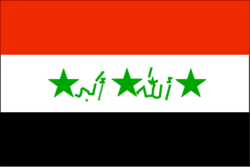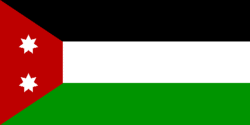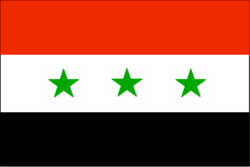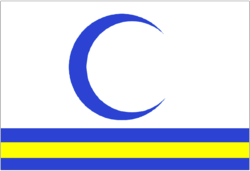Flag of Iraq
|
|
The flag of Iraq has had four different designs since the creation of Iraq in 1921. While the current situation is not entirely clear, the version in use at present is a minor variation of the design adopted under the Saddam Hussein government in 1991.
A new flag was proposed in April 2004 but was never adopted. At the ceremony on 28 June 2004 when the new interim government of Iraq was sworn into office, the stage was backed with a row of flags similar to the 1991 pattern, but wider, with the stars and the Arabic script more loosely spread across the width of the flag. The Arabic text (reading "God is Great") was also more stylized, in the Arabic Kufic script, unlike the previous text which had been loose handwriting, supposedly that of Saddam Hussein himself. The 1991 flag was raised at the Iraqi embassy in Washington, D.C. (capital of the United States) on 30 June 2004. [1] (http://www.foxnews.com/story/0,2933,124329,00.html)
| Contents |
History of the Iraqi flag
1921–1959
The original flag of Iraq was adopted in 1921, when the country was formed. It was a black-white-green horizontal tricolour, with a red trapezoid (some variants have a triangle) extending from the mast side. Two seven-point white stars on the triangle denoted the then 14 provinces of the kingdom. The colours chosen for the new flag were those of the Hashemite leaders of the Arab Revolt who provided the country with its first king, and thus it is very similar to the Flag of Jordan, another Hashemite Kingdom.
1959–1963
Following Qassim's 1958 revolution that deposed the monarchy, in 1959 Iraq adopted a black-white-green vertical tricolour with, in the middle of the white band, a red eight-pointed star with a yellow circle in its center.
1963–1991
The version of the flag used prior to that was adopted in July 1963, after the Qassim government was overthrown. The green stars were originally placed there for the proposed Union with Egypt and Syria (United Arab Republic), which both had flags with two stars in the middle at the time. They would have changed to three if the Union had not fallen apart.
1991–current
Iraq_flag_large_1991.png
The country's current national flag and ensign – the one returned to at the end of the "new flag" controversy – were adopted on 14 January 1991. The meaning of the three stars was changed from their original geographic meaning (see below) to representations of the three tenets of the Ba'ath party motto, "Wihda, Hurriyah, Ishtirrakiyah" (Unity, Freedom, Socialism). Saddam Hussein decided to place the words, "Allahu Akbar" (God is Great) between the stars. It is said (though unconfirmed) that the words on the flag are in Saddam's own handwriting, and many interpreted the change as an attempt to garner support from the Islamic world in the period immediately preceding the first Gulf War.
2004 flag controversy
On 26 April 2004 the Iraq Interim Governing Council announced a new flag for post-Saddam Iraq. The occupied government stated that from around 30 competing entries, it had chosen a design by the distinguished Iraqi artist-cum-architect Rifat al-Chaderchi (aka Rifat Chadirji) .
The flag was white, with parallel blue-yellow-blue bands across the bottom quarter or third; the blue bands represented the Tigris and the Euphrates rivers, and the yellow represented Iraq's Kurdish minority (the reason for this symbolism was unclear, but the flag of Kurdistan does feature a yellow sun). In the middle of the white field was a large Islamic crescent which was, unusually, depicted in a shade of blue.
Flags_of_the_Middle_East2.png
The design marked a notable break with the colours used in other Arab flags, which have lengthy histories – green and black are used to represent Islam and red is used to represent Arab nationalism. Islamic crescents are usually depicted in green or red in Arab heraldry. The flag's predominantly blue-on-white appearance immediately led to controversy in Iraq because of its resemblance to the flag of Israel, with whom Iraq has had considerable antagonism (indeed, a number of the original proposals for the Israeli flag did include yellow). Other critics lamented the omission of the traditional colours of Pan-Arabism and the omission of the phrase "Allahu Akbar", irrespective of who put it there.
Questions were also asked about Rifat al-Chaderchi. Apparently he is the younger brother of Interim Governing Council member Naseer al-Chaderchi and, as a result, his victory in the design competition was tainted by accusations of nepotism; in his defense, Rifat stated that he knew nothing about the plans for a new flag before receiving a telephone call from his brother inviting him to design one, and that the fact that a competition was involved was not mentioned. Additionally, because Rifat had been living in London, UK, since the early 1980s, it was easier for his critics to accuse him of failing to capture current national sentiment in Iraq.
The new flag was reported to have been burned by insurgents in Fallujah on 27 April 2004, the day before its planned official adoption. Interestingly, the flag had never yet been publicly displayed, sold, or otherwise distributed, so the desecrators were burning hand-made flags.
On 28 April, Governing Council President Massoud Barzani formally presented a modified version of the flag in which the originally very light shade of blue as reported by the press on 26 April had been changed to a darker tone; it was unclear whether this was a change made because of the protests made against the original design or, as the Council claimed, a rectification of printing errors in the earlier news reports. He also explained that the flag was a temporary design, to be used over the ensuing months until the adoption of a definitive flag.
In the face of the controversy, adoption of the blue crescent flag appears to have been abandoned. At the handover ceremony on June 28, a slightly modified version of the 1991 flag was used, retaining the "Allahu akbar" but with a stylized script replacing the handwriting. An image from the handover ceremony can be found in this CNN report (http://www.cnn.com/2004/WORLD/meast/06/28/iraq.handover/).
External links
- Iraq unveils new national flag (http://news.bbc.co.uk/2/hi/middle_east/3660663.stm) (BBC)
- Controversial new Iraqi flag unfurled (http://english.aljazeera.net/NR/exeres/94E338BA-2CAF-4267-A9FC-5C425A108CE1.htm) (al-Jazeera)
- New Iraqi flag meets with public disapproval (http://www.washingtonpost.com/wp-dyn/articles/A43438-2004Apr26.html) (Washington Post)
- Iraqis unimpressed by flag design (http://news.bbc.co.uk/2/hi/middle_east/3663387.stm) (BBC; refers to the sibling relationship between the al-Chaderchis, accusations of nepotism)
- Burning with anger: Iraqis infuriated by new flag that was designed in London (http://news.independent.co.uk/world/middle_east/story.jsp?story=515997) (The Independent, reaction of Iraqis, sibling relationship)
| National flags |
| List of national flags | List of national coats of arms |
de:Flagge Iraks et:Iraagi lipp es:Bandera de Iraq eo:Iraka flago de 2004 fr:Drapeau de l'Irak id:Bendera Irak it:Bandiera irachena he:דגל עיראק nl:Vlag van Irak ja:イラクの国旗 pt:Bandeira do Iraque ro:Steagul Irakului ru:Флаг Республики Ирак sv:Iraks flagga





